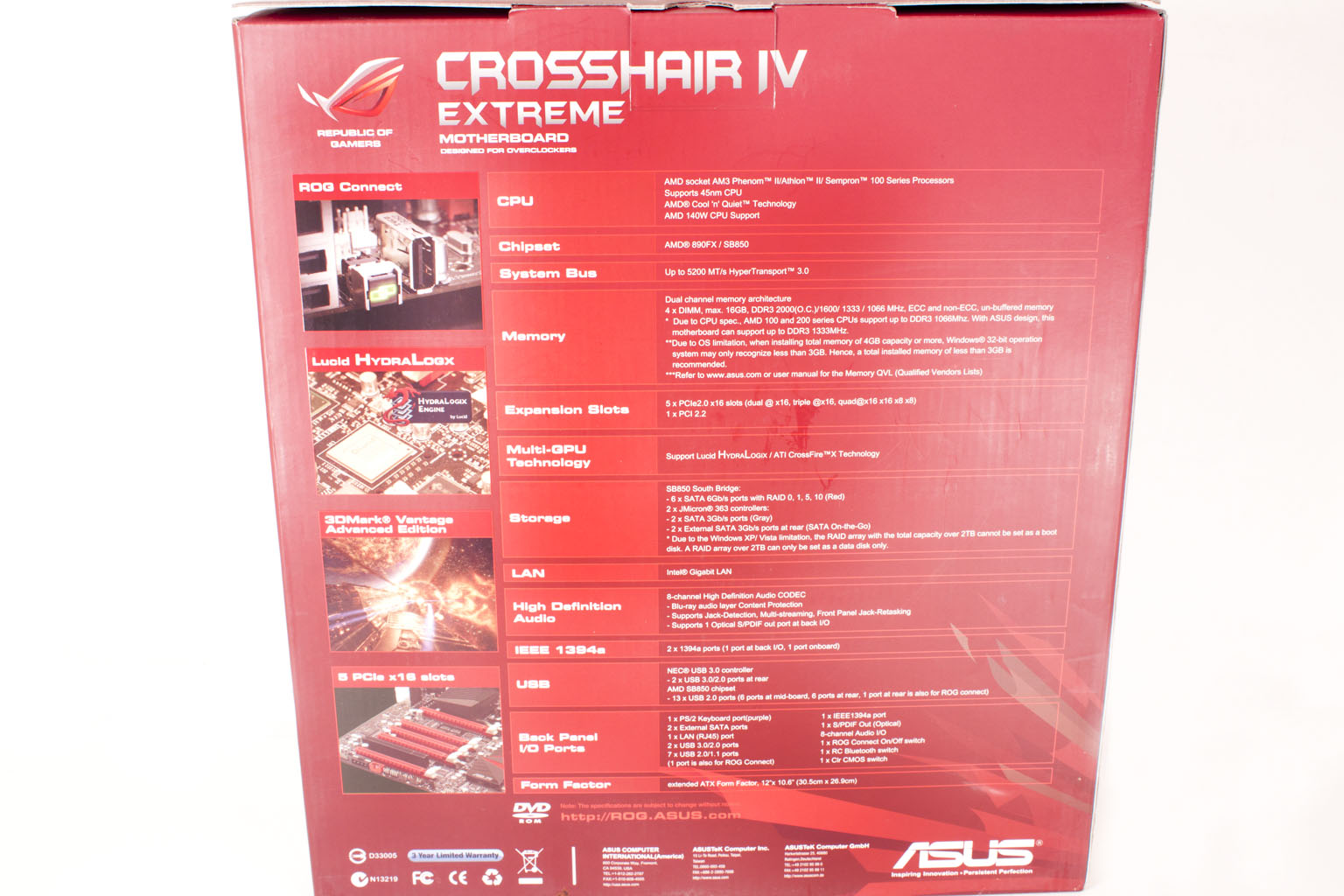The Box and Goodies -
The Crosshair IV’s box resembles all of the other boxes in the ROG line. You have the red box and the starburst in the corner. Under this front facade is a small listing of features; the ones that Asus feels are the most important. These are things like the HydraLogix chip, ROG Connect, and USB BIOS flashback all of which are actually good features (and ones that we will cover in more detail later. Below this is a window area that affords us our first look at the Crosshair IV Extreme. From what we can see here, it is a good looking board (but we will talk about that more later).
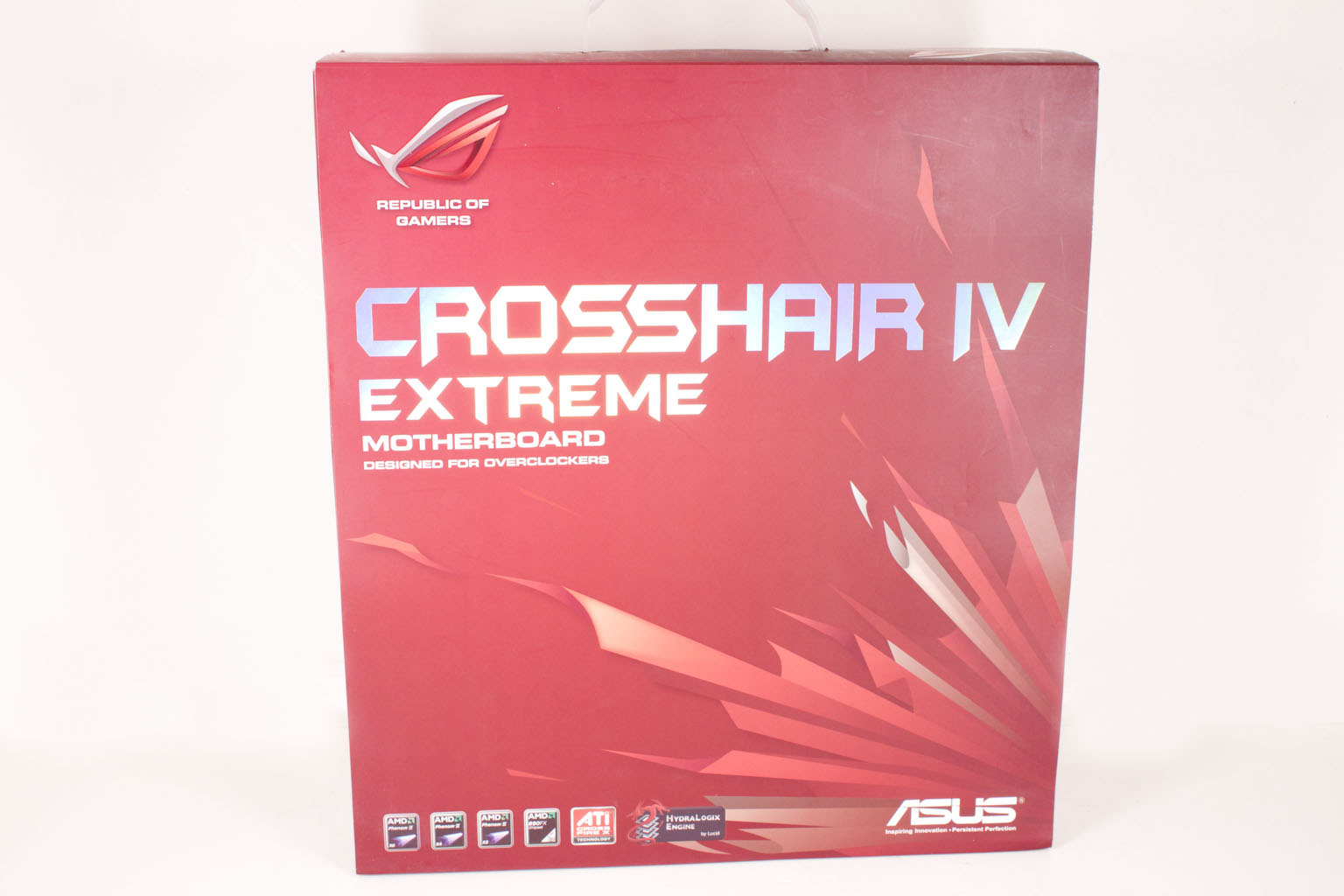 |
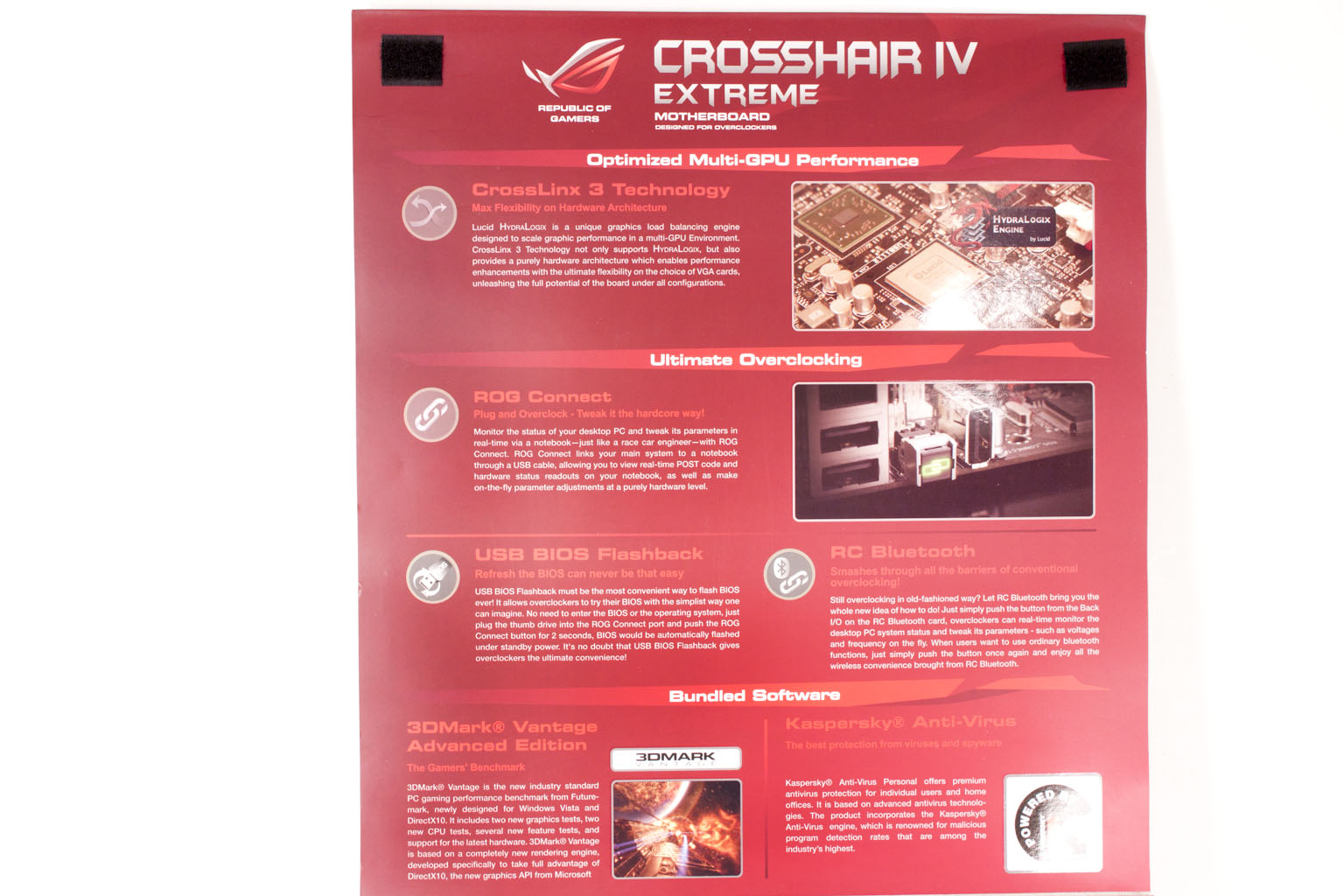 |
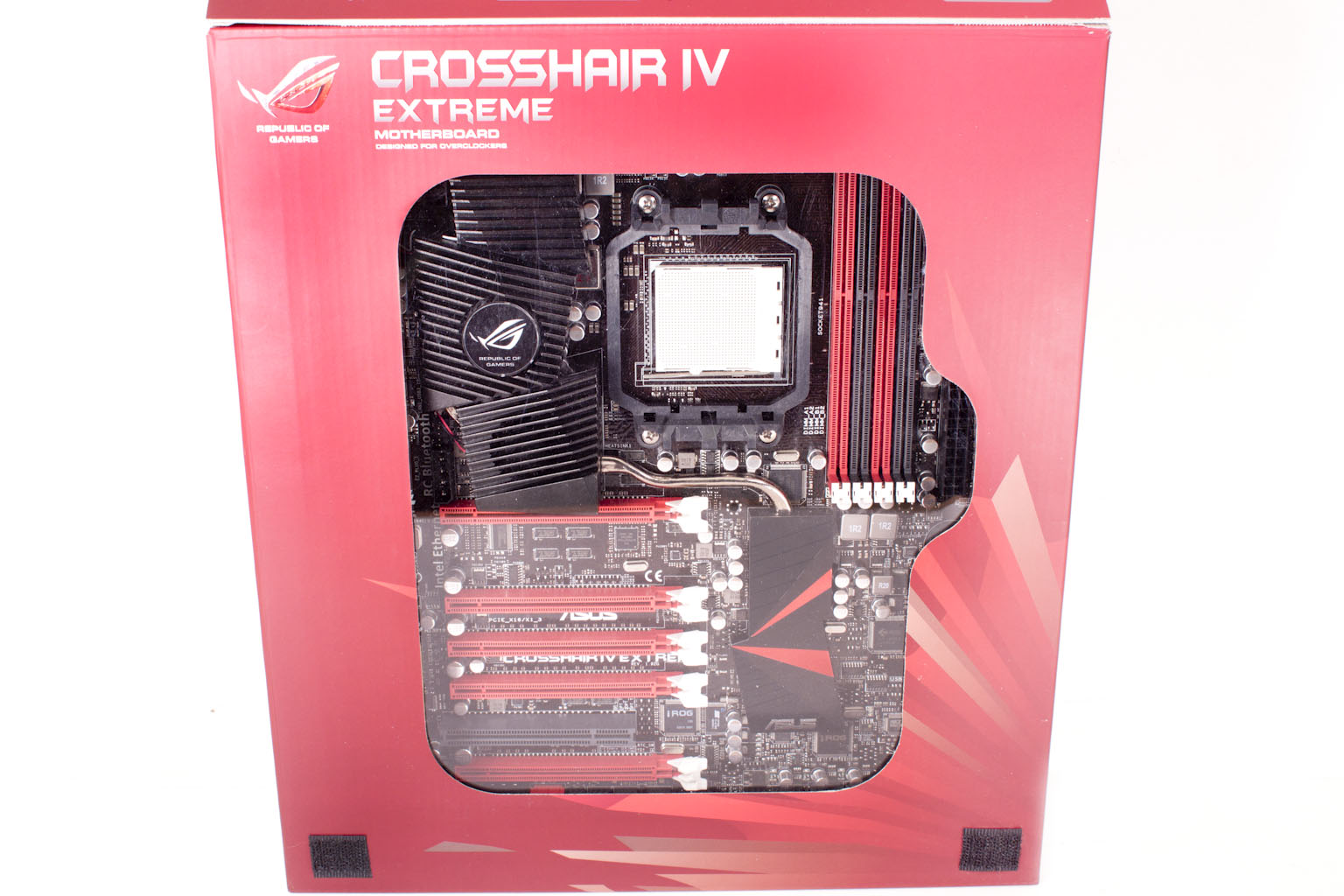 |
The back of the box is actually a little boring. It has some of the same features that are listed under that front flap and also a system specs table. Inside the box Asus has given you a decent haul of goodies for you to make the most out of your Crosshair IV Extreme. Asus Includes voltage monitor cables (these plug into a row of headers on the board), a USB/ 1394 back bracket, a few thermistors, a Bluetooth module and more. Notice that there are not a whole lot of SLI/Crossfire bridges; this is because with the HydraLogix you do not have all of the x16 ports available to link up (again we will talk more about that later).
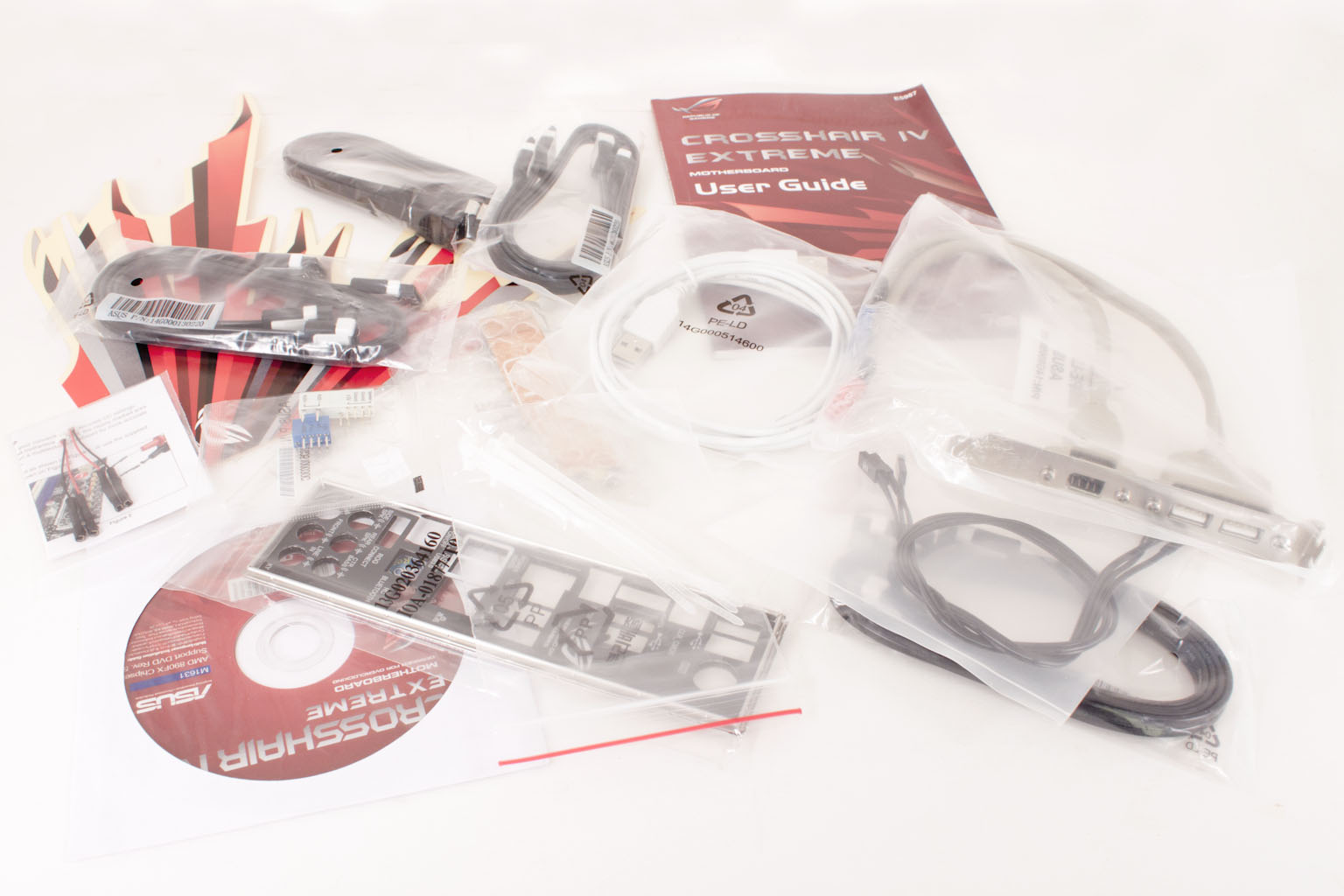 |
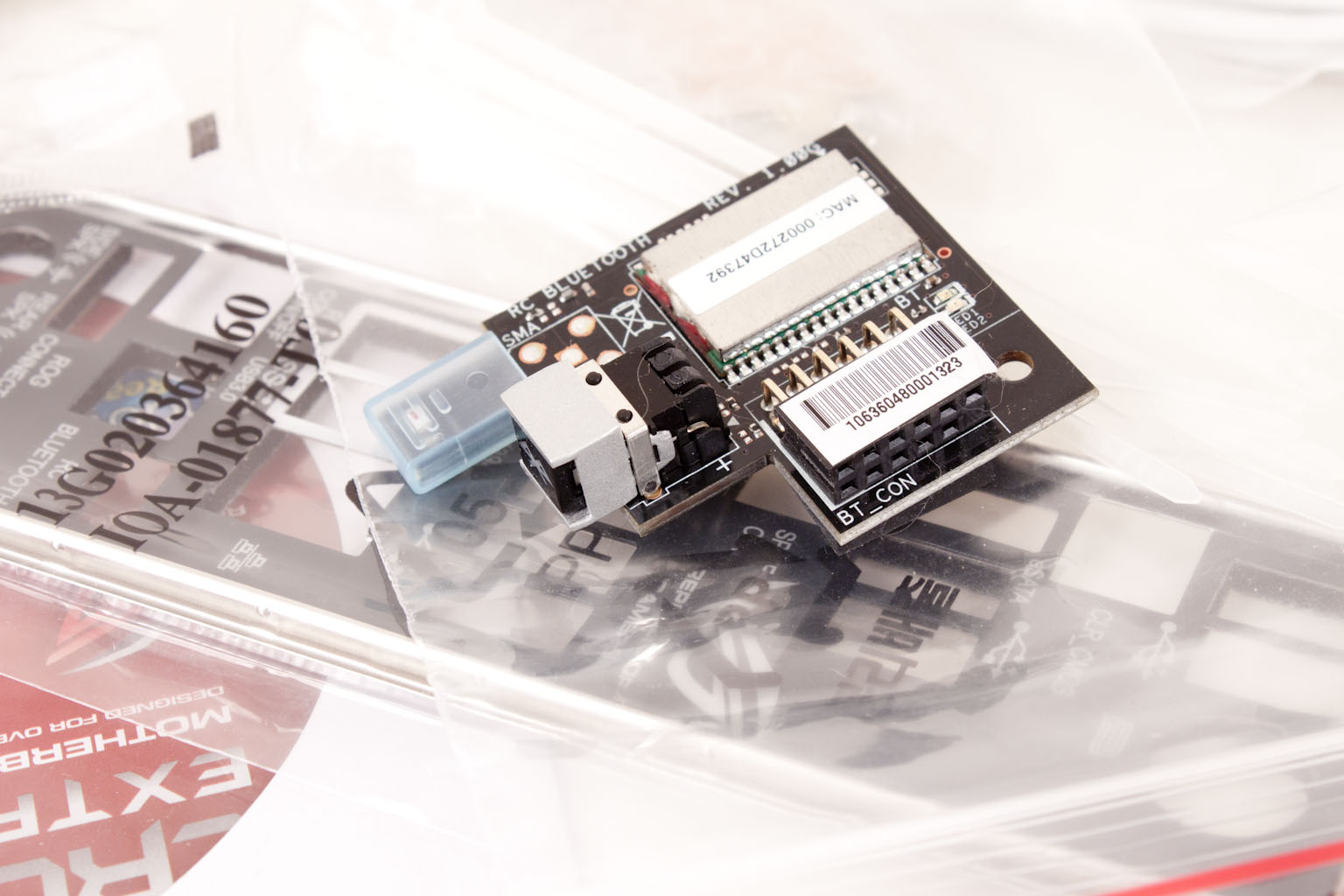 |
The Layout -
The layout of any motherboard is important. Even simple mistakes in component placement or the signal traces can cause major issued in performance and stability. With the ATX form factor we find that this is even more true; the devices we drop onto them demand more and cleaner power while the signal speeds push faster and faster. The Crosshair IV is big board; not as big as some (like the UD9) but it is still a pretty big board. Asus did this to make sure that they room for all of the tracing and components needed to build the board. If you look at the board at the proper angle it almost looks square. So let’s start our walk around in our normal place and see if we can find anything unusual.
 |
 |
The area around the RAM looks busy for a typical motherboard, although it is fairly normal for an ROG Extreme one. We see the Asus onboard controls (I like the way these look and feel better than most), right next to these are a bank of voltage read points (and their corresponding cable headers). Asus has also put in a bank of switches that allow you to turn off the PCIe slots. As you can see there are five dip switches and five slots as you move these from on to off… well you can figure it out. It is great for multiple reasons. First you can remove the power draw to them and second it also eliminates the need for the board to keep track of these. Also visible in this shot is the Go Button (for easy memory compatibility setting) and the 24-Pin ATX header.
 |
 |
Looking at the AM3 socket we find a lot that is interesting. One item of interest is the large bank of capacitors. These are all hidden away under the monumental cooling block between the CPU socket and the I/O ports. Although Asus has gotten away from this with some of their newer designs you can also catch a glimpse of the 3.3v FPCAPs that we liked so much on the Rampage III and the Maximus III. If you are wondering the reason for the overlarge cooling is to keep the Hydralogix chip cool alongside the power regulation on the board. Asus has added in some power for both the small cooling fan and also the light under the ROG logo. Along the back side of this cooling block is my favorite thing to complain about with the ATX layout. The need to have an extra power block for the CPU necessitates putting it in an awkward spot on almost every motherboard. We recommend (as we do with every board out) picking up an extension for this so that it is both easier and cleaner when you drop this in your case.
 |
 |
 |
Moving down to the lower half of the board (move your own cloak down to the lower peg…) we find the first of two 4-pin Molex connectors to provide extra power to the PCIe ports. The PCIe ports are very interesting in the way they are configured. If you are looking for straight AMD based Crossfire then you will want to put your two Radeon GPUs into slots 1 and 3. This will give you dual x16 native Crossfire (and some of your best performance). The other three (slots 2, 4 and 5) are controlled by the HydaLogix chip. Asus has included a very confusing table explaining the different scenarios but we will break it down for you here. If you want CrossfireX (dual GPU) then use Slots 1 and 2, if you are looking to run SLI or want to mix and match your GPUs you will need to slots 2, 4, or 5 to get this going. Asus goes on to say that if you are looking for a three way GPU configuration you should try and keep the three GPUs you pick identical for the best performance. Not much a surprise really, but something to keep in mind. Moving on from the dual controller based PCIe slots we find another 4-pin Molex connector that we highly recommend you use if you are going to run more than two GPUs on this board. Flipping things around to the other side we find the 8 SATA ports. All of them are SATA 3.0 as the AMD chipset supports this level of drive transfer natively. It is one of the things they have on Intel right now. You can also see the dual BIOS chips here and the small press button that lets you swap back and forth between them.
 |
 |
Now that we are done with the walk around of the board let’s look at the I/O ports. Asus provides a single PS/2 port that looks like it is meant for a mouse only (based on the port color), four normal USB 2.0 ports and two powered ones. There are also two eSATA ports on the back one powered and one not. That extra USB 2.0 port that you see is for the ROG Connect; this allows you to connect a notebook or another computer to setup overclocking on your Crosshair IV Extreme. You enable this with the little button that looks like two chain links. That Bluetooth module we talked about goes in right here and also allows you to setup an overclocking utility on your Android based phone. To round things out you also get two USB 3.0 ports, and Intel LAN controller, and a good selection of audio output options.
Let’s face it, when it comes to motherboards Asus does have a flare for design and component selection. While most people are pushing RealTek LAN chips Asus has opted to put the more stable (and faster) Intel chip on their boards.
Features -
In the current market motherboard (and indeed almost all components) performance is very close. The days of a large performance advantage between boards using the same chipset are long gone. That is unless someone makes a HUGE mistake (like runs traces completely wrong). Now, the thing that differentiates different products is the features. These are things like power management, extra slots, better audio CODECs etc. It is these items that R&D teams work so hard to drop into what are really identical pieces of hardware at their most basic level.
Over the years we have had multiple conversations with Asus and they have always talked about their commitment to pushing the level of features available on their boards. This is why we see such a large feature set on their upper end boards. It allows them to maintain a good level of feature selection even for the mid-range and lower products. The Crosshair IV Extreme has more than its share of features.
Excellent -
HydraLogix
Mix and Match GPUs
Intel LAN
FPCAPs
ROG Connect
Six Native SATA 3.0 ports
These are all excellent options for any motherboard. It is what we would expect from the flagship motherboard for the AMD CPUs.
In the middle (sort of good) -
Dual BIOS
Voltage Monitor Points
Multiple 4-pin Fan headers
Go Button
CrossfireX
iROG
Bluetooth
AI Suite II
Many of our mid-range features are still better than some of the top end ones on other boards, however since Asus is now spreading these out to their mid-range products it takes away from their top-end appeal.
Floor Mats -
Q-Connectors
Q-FAN
Board LEDs
Core Unlocker
Although the list is small these really are rather plain features when compared to the others that you get with the Crosshair IV. After all if you picked up this board for the HydraLogix, you area probably not thinking “hey cool I get little connectors for the front panel header!”. I am sure you find them nice, but it is not your big motivator.
We will cover some of these features more in their proper places but for now you can see the listing of what we see as real and what is filler or brand wide.
Conclusion Part I -
It is no secret that I like the way the Asus R&D engineers think. Their designs and component choices are often odd but usually work out very well in terms of performance and also efficiency. This is the third Extreme board we have testes in the newer ROG line up and are as impressed with this one as we have been with the X58 and P55 offerings (and we have a P67 one in the lab as well). Of course the proof is in the pudding, as they say. Still we have to wonder just what we will get from this board if once we push it and if there is any benefit to the way that Asus implemented the HydraLogix chip over some of the other manufacturers out there. If you are interested in finding out; check back in a few days when we finish up our performance testing. For now things are looking good for this $300 890FX board from Asus.
Discuss this in our Forum

